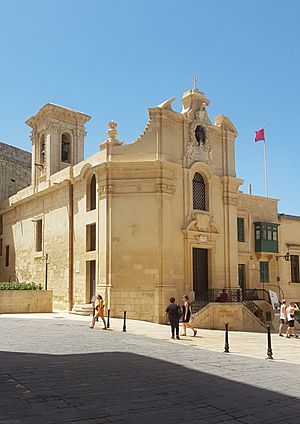Church of Our Lady of Victory (Valletta) facts for kids
Quick facts for kids Church of Our Lady of Victory |
|
|---|---|
|
Knisja tal-Madonna tal-Vitorja
|
|

The church in 2019
|
|
| 35°53′45.6″N 14°30′38.5″E / 35.896000°N 14.510694°E | |
| Location | Valletta, Malta |
| Denomination | Roman Catholic |
| History | |
| Status | Active |
| Founded | 1566 |
| Dedication | Our Lady of Victory |
| Architecture | |
| Functional status | Church |
| Architectural type | Church |
| Style | Baroque |
| Specifications | |
| Materials | Limestone |
| Administration | |
| Archdiocese | Malta |
The Our Lady of Victory Church was the very first building finished in Valletta, Malta. It used to be called the Saint Anthony the Abbot Church. After a big battle called the Great Siege of Malta in 1565, the leader of the Knights, Jean Parisot de Valette, wanted to build a church. He wanted to thank God for their victory. The church was built in 1566 and Grand Master de Valette paid for it.
Contents
Why the Church Was Built
This church was built to celebrate a huge victory. In 1565, the Knights of the Order of St John and the Maltese people won against invaders from the Ottoman Empire. This important win happened on September 8, 1565.
The church stands where a special ceremony took place on March 28, 1566. This ceremony was to start the building of the new city of Valletta. A church was chosen as the first building to show thanks. The church is dedicated to the birth of the Virgin Mary. The main painting behind the altar also shows her birth.
Grand Master Jean Parisot de Valette paid for the church's construction. He passed away on August 21, 1568, and was buried in the church's crypt. Later, when St. John's Co-Cathedral was built, his remains were moved there.
Changes Over the Years
In 1617, the Knights of St John chose this church as their main parish church. It was then dedicated to St Anthony the Abbot. In 1699, the back part of the church, called the apse, was made larger. This was ordered by Grand Master Ramon Perellos y Roccaful.
In 1716, a Maltese artist named Alessio Erardi was asked to paint the ceiling. He painted scenes from the life of the Virgin Mary. These paintings were finished in two years. In 1752, the front of the church, the sacristy (a room for priests), the bell tower, and the priest's house were all made bigger. The front of the church got a beautiful Baroque style. It also has a bronze statue of Pope Innocent XII. Later in the 1700s, two more altars were added, besides the ones for St John the Baptist and St Paul.
Modern History and Restoration
In 1837, the church became the Garrison Church for the Royal Malta Fencible Regiment. This group later became the Royal Malta Artillery. Over the years, the church suffered some damage to its structure and paintings. On April 23, 1942, during World War II, the church ceiling was damaged by an air raid on Valletta. This raid also destroyed the nearby Royal Opera House.
On September 8, 1943, another important event happened. The Italian fleet surrendered during World War II. Because of this, the church was once again known as 'Our Lady of Victory'.
In 2000, a group called Din l-Art Ħelwa, which is Malta's National Trust, began a project to restore the church. On September 8, 2011, the government of Malta officially made Din l-Art Ħelwa the guardian of the church. The restoration work has continued since then.
Artistic Treasures Inside
The church holds many beautiful artworks. Above the altar, there are paintings of St Anthony of Egypt and St Anthony of Padua. These paintings were brought to Malta in 1530 by the Knights of Malta. This happened after Emperor Charles V gave the island to the Order of St John as their home. The church also has works by other artists like Francesco Zahra, Ermenegildo Grech, and Enrico Arnaux.
In 1792, a Venetian Grand Admiral named Angelo Emo passed away in Malta. He wanted his heart to be buried in the Lady of Victory church. A monument in his honor, made by Maltese sculptor Vincenzo Dimech, was put up in 1802.
The Church Today
In 2000, Din l-Art Ħelwa, the National Trust of Malta, started a big restoration project. They worked with the Valletta Rehabilitation Project and the Museums Department. The roof, decorative parts, and a section of the bell tower were repaired. Computime helped pay for this. The outside of the church was fully restored by 2002, with PricewaterhouseCoopers as a main sponsor. The work on the inside of the church began in 2004. The church was fully restored between 2015 and 2016.
The Church of Our Lady of Victory is listed on the National Inventory of the Cultural Property of the Maltese Islands. This means it's an important historical building.
The church is open to everyone to visit for free.
Images for kids
See also
 In Spanish: Iglesia de Nuestra Señora de la Victoria (La Valeta) para niños
In Spanish: Iglesia de Nuestra Señora de la Victoria (La Valeta) para niños
- Culture of Malta
- History of Malta
- List of churches in Malta
- Religion in Malta



